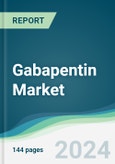The gabapentin market is estimated to grow at a CAGR of 3.82% during the forecast period.
When used with other drugs, gabapentin oral solution, pills, and capsules assist individuals with epilepsy in controlling seizures. Additionally, postherpetic neuralgia (PHN), which is characterized by searing, stabbing pain or pains that can last for months or years following an outbreak of shingles, is treated with gabapentin capsules, tablets, and oral solutions. RLS, a disorder that causes pain in the legs and a strong impulse to move the legs, especially at night and when sitting or lying down, is treated with gabapentin extended-release tablets (Horizant). Further, Gabapentin cures seizures by reducing excessive brain activity.Driving factors for the gabapentin market
The major factor influencing the growth of the gabapentin market is the increasing incidence of neuropathic pain and seizures and the rising utilization of pain management drug. Rise in government initiatives, R&D investments by pharmaceutical companies, and an increasing geriatric population are the key factors fueling the gabapentin market growth.Increasing use for pain management
The medication gabapentin is used to relieve nerve discomfort. Typical medicines frequently fail to provide relief for this kind of discomfort. Gabapentin alters the way nerves communicate with the brain. A nerve can transmit erroneous signals to the brain when it is compressed or when it isn't functioning correctly in any other manner. Even when a portion of the body is not wounded, the brain perceives it as such. Gabapentin lessens the pain by changing the way nerves function.Development of new formulations for Gabapentin
Anticonvulsant medication gabapentin is used to treat neuropathic pain and partial seizures and positively impacts the gabapentin market growth. The pharmacokinetic characteristics of medicinal medicines can be enhanced by the use of nisomes, a class of lipid-based drug carriers. In this work, a niosomal formulation of gabapentin was created, and the optimal niosomal formulation's cytotoxicity impact was assessed on normal cells and colon cancer cell lines. Numerous niosomal formulations were created, and the physicochemical characteristics of each were examined. The release profile for the G3 and G4 formulations closely matches the Korsmeyer-Peppas model and suggests the Fickian diffusion mechanism for gabapentin release.Growing use in healthcare and clinics
Primary care physicians, mid-level practitioners, neurologists, internists, and orthopedic surgeons frequently prescribe gabapentin to treat a variety of medical conditions. In addition to its anti-seizure abilities, the medication has other applications. Nurses assist the physician by serving as a point of contact, reviewing doses, and responding to patient inquiries. The likelihood of gabapentin abuse is known to every member of the interprofessional team. The coordination of an interprofessional team in this way maximizes the benefits of gabapentin therapy while minimizing any possible side effects. This growing knowledge about the utilization is boosting the gabapentin market.Increasing utilization in off-label medical practices
In medicine, especially psychiatry, gabapentin is frequently administered outside of its approved uses. The United States FDA issued a warning about the dangers of combining the medication gabapentin with central nervous system depressants (CNS-Ds), which are frequently recommended for psychiatric therapy. This focuses on concurrent CNS-D drug usage and off-label outpatient gabapentin use for psychiatric purposes.In North America, it is projected that the gabapentin market will grow steadily.
North America is anticipated to hold the biggest revenue share in the gabapentin market owing to the high incidence of neurological diseases and ailments characterized by persistent pain in the area may be the reason for the dominance. The FDA is in favor of generic drug launches in the area, which will increase product availability in the United States. Furthermore, Asia Pacific is anticipated to be the second largest growing gabapentin industry, owing to the increase in awareness about the medications.Merger & Acquisitions
- In April 2023, GSK plc and BELLUS Health Inc. reached an agreement under which GSK will acquire BELLUS, a Canadian late-stage biopharmaceutical company that is working to improve the lives of patients with refractory chronic cough (RCC), for US$14.75 per share of common stock in cash, or roughly US$2.0 billion (£1.6 billion) in total equity value.
- In December 2022, JanOne purchased Soin Therapeutics and its LDN medication, which is now known as JAN123, under the terms of the Purchase Agreement. JAN123 is a brand-new LDN formulation with a biphasic product release that contains 2.0 mg of LDN.
Market Key Developments
- In September 2023, the leading global pharmaceutical company Lotus Pharmaceutical collaborated with the leading B2B pharma player, Adalvo, to announce the introduction of Gabapentin ER 300/600 mg in South Korea.
- In March 2023, the pharmaceutical company Granules India Ltd. announced that the US health agency has approved its generic gabapentin pills for use in treating postherpetic neuralgia in adults. According to Granules India in a regulatory filing, the US Food & Drug Administration (USFDA) has approved the abbreviated new drug application (ANDA) for gabapentin tablets in the strengths of 600 mg and 800 mg.
Segmentation:
By Type
- Generic
- Branded
By Application
- Epilepsy
- Neuropathic Pain
- Restless Legs Syndrome
- Others
By Distribution Channel
- Hospital Pharmacy
- Retail Pharmacy
- Others
By Geography
- North America
- United States
- Canada
- Mexico
- South America
- Brazil
- Argentina
- Others
- Europe
- United Kingdom
- Germany
- France
- Spain
- Others
- Middle East and Africa
- Saudi Arabia
- UAE
- Israel
- Others
- Asia Pacific
- Japan
- China
- India
- South Korea
- Indonesia
- Thailand
- Others
Table of Contents
1. INTRODUCTION
2. RESEARCH METHODOLOGY
3. EXECUTIVE SUMMARY
4. MARKET DYNAMICS
5. GABAPENTIN MARKET, BY TYPE
6. GABAPENTIN MARKET, BY APPLICATION
7. GABAPENTIN MARKET, BY DISTRIBUTION CHANNEL
8. GABAPENTIN MARKET, BY GEOGRAPHY
9. COMPETITIVE ENVIRONMENT AND ANALYSIS
10. COMPANY PROFILES
Companies Mentioned
- Pfizer
- Fierce Pharma
- Mayo Clinic
- Ralington Pharma
- Teva Pharmaceuticals
- Gralise
- Glenmark Pharmaceuticals
- Stensa Lifesciences
- Rosemont Pharmaceuticals
- Lupin
Methodology

LOADING...








